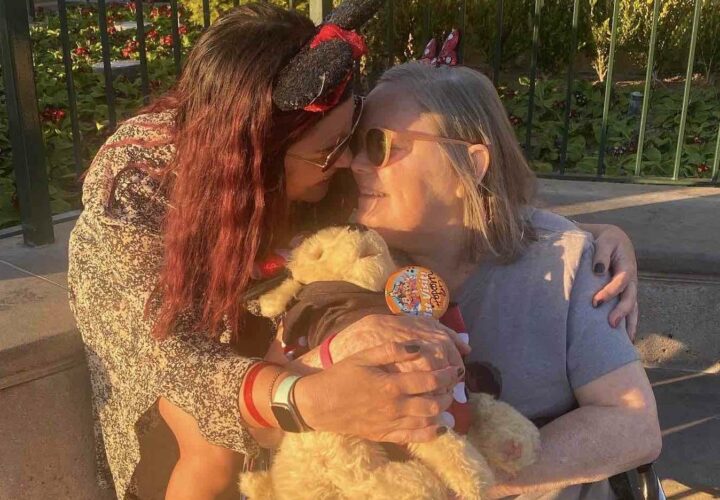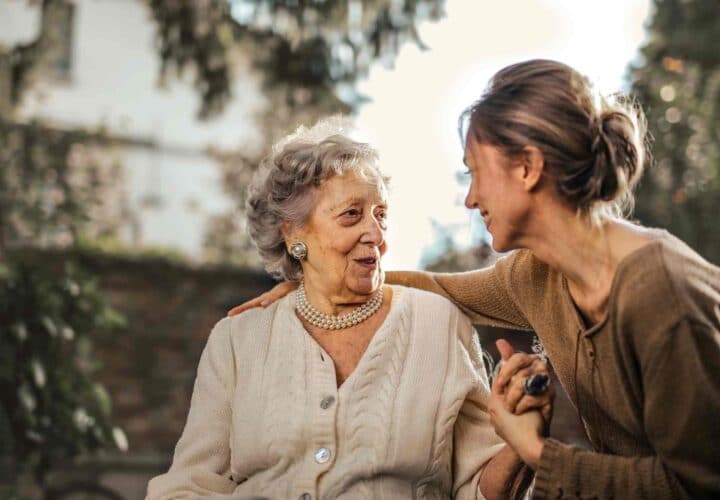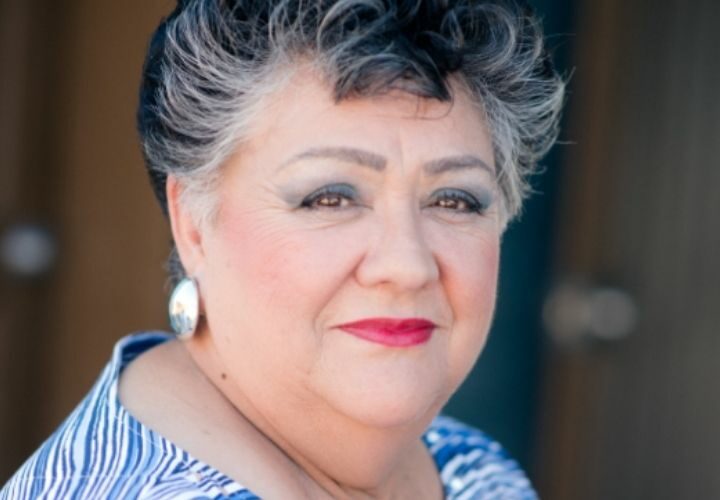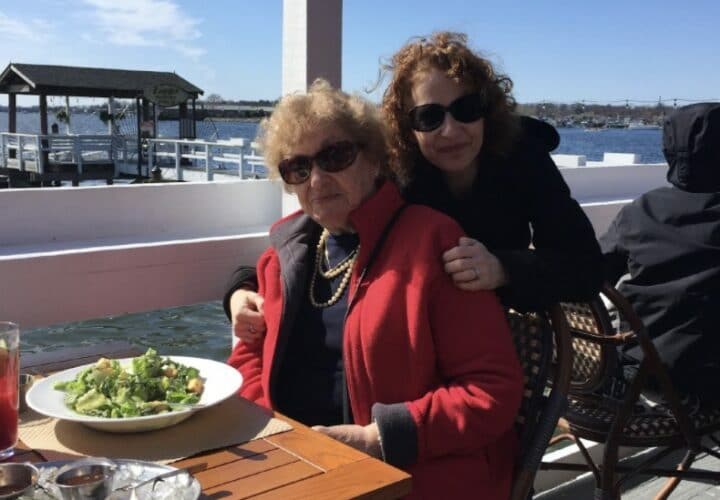Patti LaFleur speaks about the bond between her and her mother Linda LaTurner who is living with dementia.
Patti LaFleur sees her relationship with her mother Linda LaTurner as a partnership. LaFleur cares for her mother full-time, and she describes LaTurner as someone who is always giving back, even if it’s with something as simple as a smile. For LaFleur, 35, looking after her mother is a chance to return the unwavering love and care that LaTurner, 73, gave in raising her.
In Being Patient’s LiveTalk series, LaFleur, a former kindergarten teacher, shares her fellowship with LaTurner in journeying through dementia, and her advice for finding joy, support and time for self-care as a caregiver.
Being Patient: Tell us a little bit about your mother and your upbringing.
Patti LaFleur: My mom is wonderful. My mom is one of those people that was made to be a Mom. I was actually adopted. She adopted both me and my sister because she was unable to have kids. I truly feel like we were meant to be.
All of the positive qualities that I have, I got from her 100 percent. She was always supportive and always making sure that we were loved and cared for. I never doubted that she loved me, and she was going to support anything that I was interested in. She was the biggest cheerleader.
Being Patient: With roughly five years into your mother’s journey with dementia, you recently quit your job as a kindergarten teacher to devote more time to her. Going back in time, what was it like juggling all your different responsibilities?
Patti LaFleur: At the time of her diagnosis, I was teaching kindergarten full-time. I was also going to the University of Washington to get my Master’s in instructional leadership. I was in the middle of starting to plan my wedding. At the time, my boyfriend and I had just gotten engaged. I had a lot of things going on.
We discovered that my mom had dementia because she’s also a type 1 diabetic and she was really struggling with being able to manage her blood sugar. She had always done a beautiful job in caring for that, and she was missing insulin doses or she was struggling counting carbs.
Then there were other things that started to pop up. She was withdrawing from social situations. She was experiencing more sadness or isolation, feeling like she wasn’t able to engage or be involved in conversations in the same way.
She also had always paid all the bills. She was a stay-at-home mom. She ran the household beautifully. She started to miss paying the bills, and we were getting late notices. Things that were not typical behaviors for my mom were popping up.
Being Patient: Eventually, your father also developed dementia. That must have been so tough for you.
Patti LaFleur: It was very challenging. At first, my mom didn’t need a ton of support when my dad was caring for her. [She] just [needed] some support with her insulin [and] some support with day-to-day functioning. But she was requiring a lot more help with day-to-day tasks by the time I stepped in and was helping my parents in their house, and [when she moved] in with me.
It was hard because my dad was trying to not lose his independence as well. He had watched his wife go through this. He was doing a lot of things that made it appear that he was fine. But … I noticed that there were other things going on that weren’t normal parts of aging.
Before he passed last year, he was still very much in the early stages. He was living in an assisted living facility, but he was independent in a lot of ways. We were still able to have lots of conversations. He was still able to use the phone and even do video calls. He definitely had not progressed as far in his dementia, but they both required me to be handling everything: finances, doctor’s appointments, driving. The list goes on and on.
Being Patient: You wrote in an article that you use the term “care partner” rather than “caregiver.” Why is that?
Patti LaFleur: I fully believe that it’s a partnership. This is not a one-way street. There are some days where I am giving a lot more, but she is constantly giving back. I’m a big believer in intentionality and language.
“I fully believe that it’s a partnership. This is
not a one-way street. There are some days
where I am giving a lot more, but
she is constantly giving back.”
By using a term like care partner and being really intentional with how I define our relationship, it’s able to help me find joy and find the ways that she is giving back to me. Every day, there’s reciprocation, even if it’s a smile or holding my hand … We’re equal in this partnership … We’re working together to live both of our best lives.
Being Patient: You offer several advice for caregivers in a separate article, one of which is to “do your best to find joy.” How do you find joy alongside your mother?
Patti LaFleur: We find joy every day. Every day, there’s something to celebrate. Every day, there’s something to be excited about. We have fun every day. We laugh every day. We dance. We do art together. We bake together. What is life without joy?
There’s so much stigma around words like dementia and Alzheimer’s, as [if] this is a death sentence, or your life is over, or it’s terrible and miserable. Yeah, it’s hard. I’m never going to say that I want [anyone] to have dementia. But when you are living with it, you can choose to be negative and choose to find all of the things that are hard about it, or you can find the moments of joy.
We do everything together. I don’t let dementia be the thing that stops us from having fun. That’s why I’m constantly posting about it, talking about it, sharing videos and raising awareness … My biggest advice to other care partners is: Find things that you can do together. It’s not about the activity itself. It’s about the experience, and don’t [get caught up with what you think is supposed to happen] … Just go with it.
Being Patient: Another one of your advice is to “find time for yourself.” How do you apply that in your daily life?
Patti LaFleur: I can’t show up as my best self for her if I don’t feel my best. For me, one of the biggest things is working out or making time for exercise … [Make] some small shifts in your day or in your schedule to make time for yourself.
I’m a very scheduled person. We follow a routine every day. In that routine, I build in time for myself. She goes to bed at the same time, so when she goes to bed, I have an hour to myself. I can pick a glass of wine, do a journal, watch a TV show, walk on the treadmill, or call a friend.
I make sure that there are times throughout the day that are just for me. I give so much of my day to her, which is fine, but I also need to make sure I make time for me.
About six months ago, I found a memory care facility in the area, and once a month or once every couple months, she goes there for a weekend … She gets a break from me. I get a break, and I prioritize those weekends to spend time with my friends [and] my husband. If I want to go and do something that I don’t necessarily want Mom to do with me, that’s when I go and do those things. I make myself as important as a partner in this partnership as she is.
We did have caregivers coming into the home and they were wonderful, but I found when they were coming into the home, I either had to be out of the home so that I’d have a break, or I was in the home and talking to them, so it [wasn’t] really a break.
Being Patient: Lastly, you encouraged fellow caregivers to “find a support system.” What steps have you taken to build this system?
Patti LaFleur: [Communicate] to people in your life, like your friends and your family, what you’re going through. All of my friends are completely aware of what I’m going through. I talk to them about my mom. They spend time with me and my mom.
I’m very open [in communicating that] ‘I may make a plan with you and it may include my mom and things can come up.’ They understand that because I’ve been forthright in my communication.
Then, I also would say that there are a lot of other people going through the same thing … There are a lot of wonderful support systems online. I started sharing my journey on Instagram, and not even intentionally, I started connecting with people.
I had attended some support groups, which were lovely and wonderful, but [people] were not in their 30s. The people that I have met through online support systems, more millennial-type caregiver resources, have been some of the best connections that I’ve made. They get it. We talk daily. I’ve been contemplating when [it is] time for hospice. I can ask them and they can share their experiences.
Even [finding] one person that you can connect with and understands [your experience], through an Alzheimer’s Association support group or any other sort of support group, goes a long way. Sometimes, it’s nice to know you’re not alone.
The interview has been edited for length and clarity.



